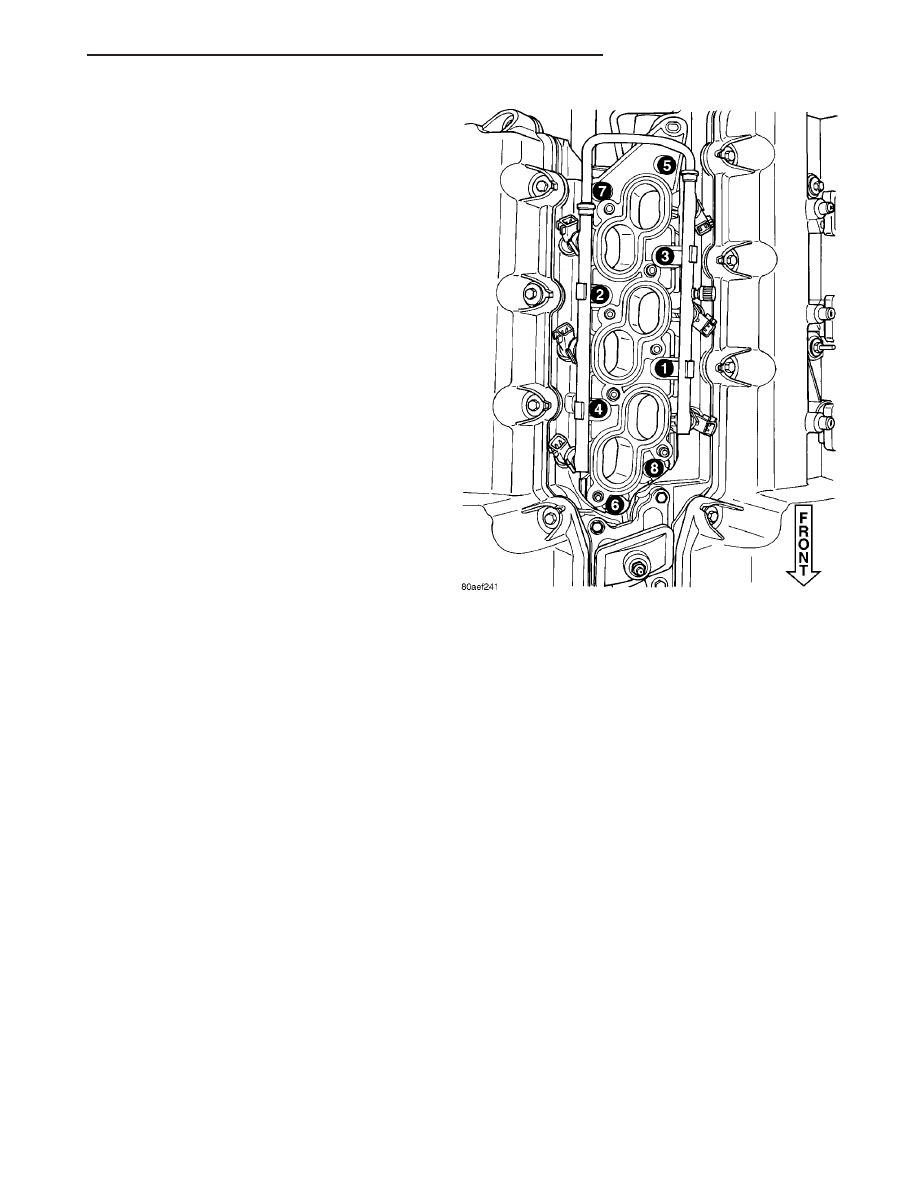Chrysler Sebring, Stratus sedan, Sebring Convertible. Manual - part 531

(6) Connect electrical connectors to the following
components:
• Manifold Absolute Pressure (MAP) Sensor
• Throttle Position Sensor (TPS) Sensor
• Idle Air Control (IAC) Motor
(7) Install throttle cable bracket.
(8) Connect throttle and speed control cables to
bracket and throttle arm. Install throttle cable
shield.
(9) Install throttle body air inlet hose and air
cleaner housing assembly.
(10) Connect negative battery cable.
INSTALLATION - INTAKE MANIFOLD LOWER
(1) Clean and inspect sealing surfaces of cylinder
head and manifold. Gaskets can be reused provided
they are free of cuts or tears.
(2) Position manifold on cylinder head surfaces.
NOTE: For ease of installing upper intake manifold,
install a bolt 2 – 3 turns to the rearmost attaching
hole of intake. This will properly position lower
manifold.
(3) Install fuel rail with injectors.
(4) Install manifold attaching bolts and tighten in
sequence shown in (Fig. 111) to 12 N·m (105 in. lbs.).
Remove bolt used for aligning manifold.
(5) Connect the fuel injector electrical connectors.
NOTE: Make sure fuel injectors are located in the
correct location and position, as upper intake man-
ifold interference could occur.
(6) Install
screw
attaching
fuel
rail
support
bracket to the throttle body support bracket.
(7) Connect fuel supply hose to fuel rail. (Refer to
14 - FUEL SYSTEM/FUEL DELIVERY/FUEL LINES
- STANDARD PROCEDURE)
(8) Install upper intake manifold. (Refer to 9 -
ENGINE/MANIFOLDS/INTAKE
MANIFOLD
-
INSTALLATION)
EXHAUST MANIFOLD
REMOVAL
FRONT EXHAUST MANIFOLD
(1) Disconnect negative battery cable.
(2) Disconnect and remove oxygen sensor.
(3) Raise vehicle on hoist.
(4) Remove exhaust cross-under pipe (Refer to 11 -
EXHAUST
SYSTEM/CROSS-OVER
PIPE
-
REMOVAL).
(5) Remove front catalytic converter (Refer to 11 -
EXHAUST SYSTEM/CATALYTIC CONVERTER -
REMOVAL).
(6) Lower vehicle.
(7) Remove exhaust manifold attaching bolts and
remove manifold.
REAR EXHAUST MANIFOLD
(1) Disconnect negative battery cable.
(2) Remove throttle body air inlet hose and air
cleaner housing assembly.
(3) Remove bolts attaching EGR tube from exhaust
manifold and EGR valve. Discard gaskets.
(4) Raise vehicle on hoist.
(5) Remove exhaust system from vehicle (Refer to
11 - EXHAUST SYSTEM - REMOVAL).
(6) Remove exhaust cross-under pipe (Refer to 11 -
EXHAUST
SYSTEM/CROSS-OVER
PIPE
-
REMOVAL).
(7) Remove rear catalytic converter (Refer to 11 -
EXHAUST SYSTEM/CATALYTIC CONVERTER -
REMOVAL).
(8) Disconnect and remove rear upstream oxygen
sensor.
(9) Remove rear exhaust manifold heat shield.
(10) Remove exhaust manifold attaching bolts and
remove manifold.
Fig. 111 Lower Intake Manifold Tightening Sequence
JR
ENGINE 2.7L DOHC
9 - 227
INTAKE MANIFOLD (Continued)